“The Salmon Are Running!”
To some Alaskans (quite a few), the call of the salmon run is irresistible. The act of fishing turns from sport to simply “getting” fish. And of course, the commercial interests shift into high gear as well. The crowds are legendary during the peak salmon runs, as everyone tries to get their share of the bounty. Here is a scene from a beach near Kenai, during dip-netting season. It’s this way for miles.
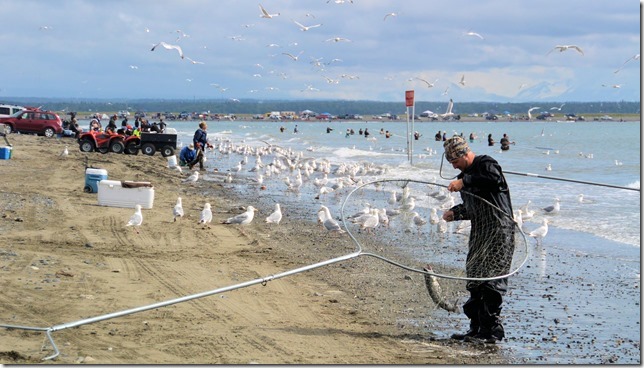
We hadn’t heard of dip-netting before. It goes like this: the fisherperson wades out into the water and holds a huge net vertically in the water. Think of a 4-foot diameter tennis racket, waiting for a serve.
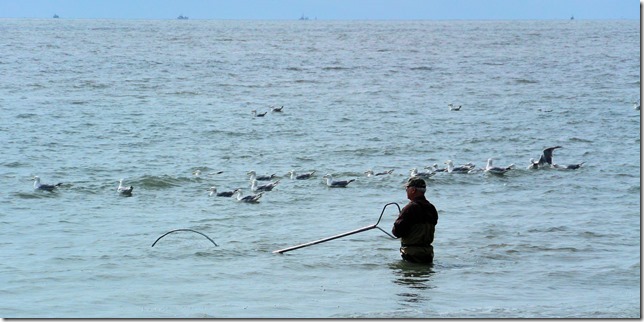
After a while, some hapless fish swim into the net, and the lucky man or woman hauls out onto the beach, and untangles the frantically flopping silvery swimmer from the twine. (This can be quite entertaining to watch.) The next steps are pretty simple: clobber the fish with a billy club for a quick kill, then either simple-clean it (head and guts) or full-filet it. If it’s a female, the roe is saved. Then walk back into the water for more. Continue until limit is reached.
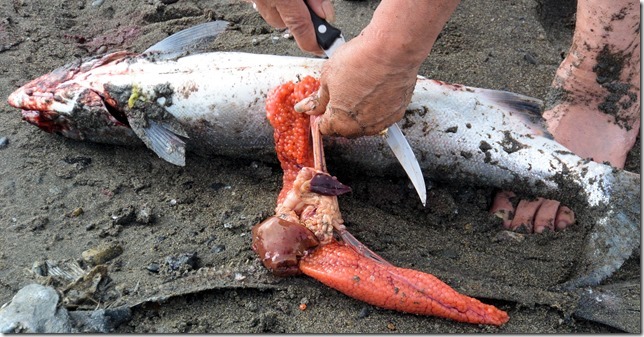
The offal and carcasses are thrown out to sea (to avoid attracting bears), but the tidal action brings them right back in to some extent. We saw one woman who “caught” a fileted skeleton in her dip-net. Sights like these non-fossilized remains are common all over the beach.
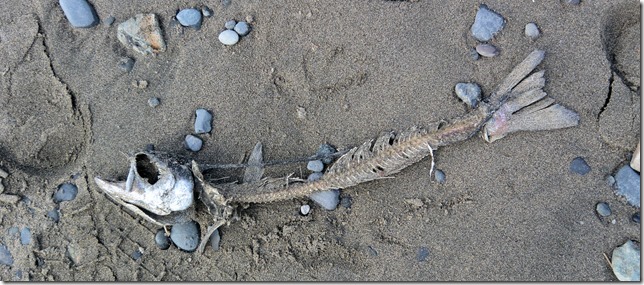
Salmon don’t just drift back and forth from ocean to streams, they essentially migrate, and they do it in measureable and largely predictable patterns (at least in the short-term). Up here in Salmon Central, Alaska, the seasons, species, catch limits, and size limits are all closely regulated, many times down to specific hours. The big fisheries are zealously protected from over-fishing, and with as popular as this fish is, heavy regulation is what is called for. This year, there were 2.3 million sockeye salmon to parcel out, and that’s only the late run. The kings, chubs, silvers, and cohos all have their own populations and runs as well.
Karin and I don’t fish. We are not fish-persons. (We don’t actually even eat that much fish, although we know we should and it’s healthy for us.) There, sins confessed. And so it is that we feel a little out of place when we are surrounded by our opposites. In every grocery store, auto service center, beauty parlor and campground, the talk is fishing. When to go, where to go, what to use, how the runs are doing, and on and on. And anywhere the fish are running, the mobs are congregating as well. On the way west toward Kenai, we made a stop briefly at Russian River campground on the Sterling highway, just to see what it was all about. Not to fish, just to look. TWELVE cars in line at the normally vacant campground entrance (campground was full) made it impossible for us to even get a glimpse without an hour’s wait.
It’s all a lot like these gulls, scurrying to scarf up some tossed-away fish guts. Jam-packed and a bit frantic.
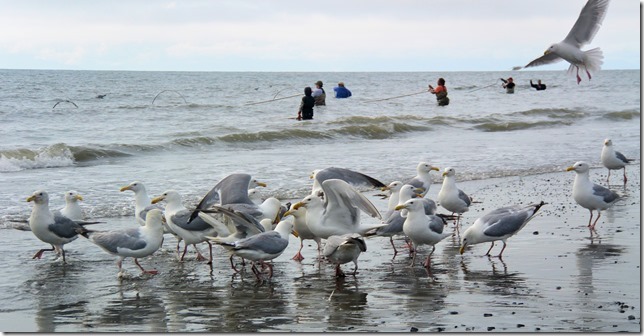
The fish-gathering is ubiquitous, everywhere that fishing is permitted. There’s commercial net-fishing, dip-net fishing, snag-fishing (no bait, just snag them with a hook), and even regular old bait-fishing (for some species – many of the spawning salmon don’t eat after they hit fresh-water).
To put some space in between us and the teeming crowds, we drove north about 40 miles above Soldotna on a dead-end road. The Captain Cook state park does not allow fishing, and it’s far enough off the beaten path that we hoped to enjoy some peace and relative solitude.
The first part of the drive was a little disconcerting. Stretches of the Kenai Spur Road are definitely industrial, and the area was looking anything but wild and scenic, with tank farms and helicopter-cargo overflights.
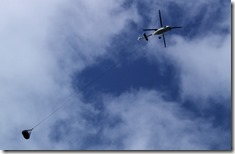
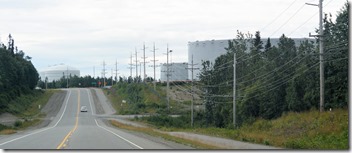
But it turned out that Discovery campground was a really good choice. The “industrial zone” was far behind, and the overflights infrequent. We got a site overlooking the beach cliff, with 30 yards between neighboring camp sites. There’s a bald eagle nest over our heads, and we can hear the young fledgling shrieking and flapping and getting ready to test the air some day.
Sunsets are gorgeous across the Cook Inlet, with low-tide tidal flats and exposed boulders accenting the close of the day.
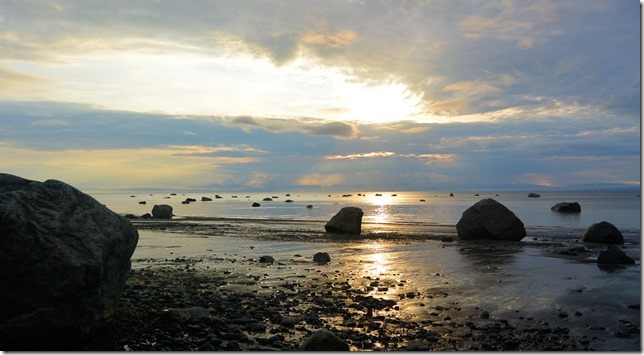
Tides in the Inlet run to almost 30 feet – so all those rocks are totally concealed twice a day during high tide. Predictably, we don’t see a lot of boats out in this area (but there are some, brave souls tending the off-shore nets).
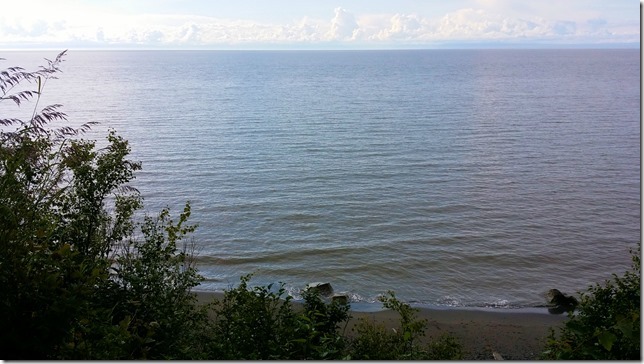
Discovery camp became a very pleasant time for us, and we stayed there for four nights. We spent our time doing some chores and shopping (commute to Kenai in Ralph), and hiking and driving on the beach.
Alongside the park, the beach is deserted, a wonderful walk through coarse gravel and dotted boulders. We have a choice of a steep cliff-side path (we only tried this once) or a less tricky but longer walk down an access road. They each have their pros and cons
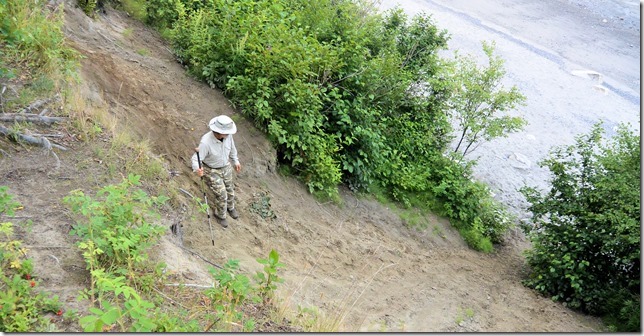
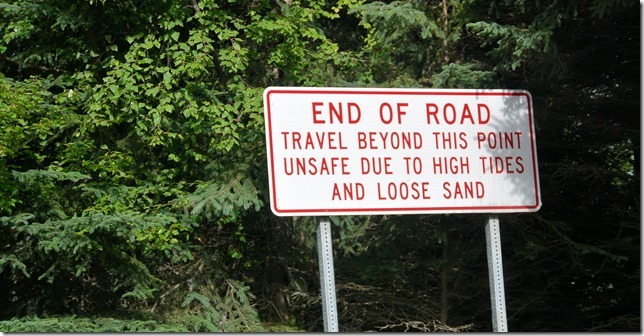
It’s a wonderful beach, full of eye-catching stones and different textures. There wouldn’t be much of it at high tide, so our walks and drives were mostly during low water.
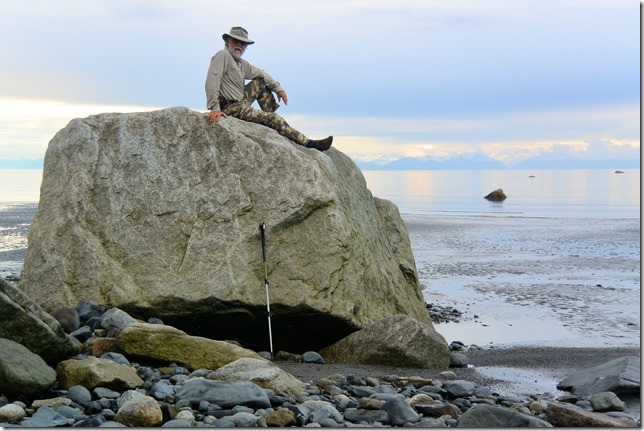
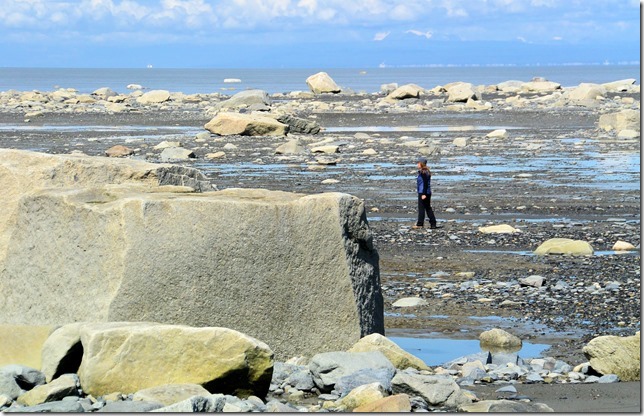
We had to be careful with Ralph. We learned that one guy got his truck stuck in the sand and had to leave it through a tide cycle. It was totaled – windows gone, paint sanded off, an absolute junk pile. So we picked our way slowly and carefully through the occasional rock garden.
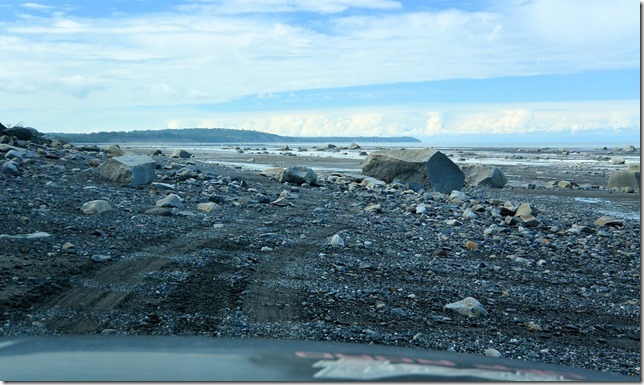
One of the interesting features north of the park is the seine-fishing setup. Here, commercial fishing runs nets between bright orange buoys. We were amazed to find that they tend the nets from small boats. We have no idea how they navigate the rock jungle, which can be just barely submerged at higher tide levels, and ready to munch a boat hull. Here, you can just see the net they are tending. The buoy is “floating” on a mud flat. (White areas to the left are far-shore cliffs; derricks to the right are on oil platforms across the Inlet.)
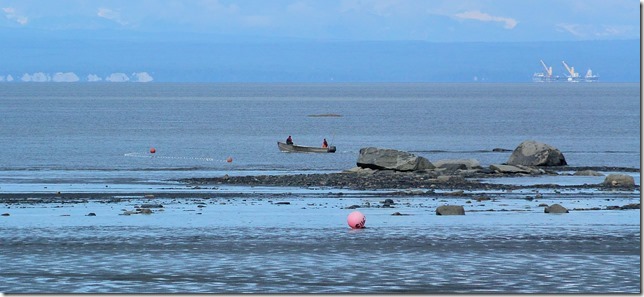
On the way back to camp, we passed a family of three in a beat-up beach car, a seen-better-days compact SUV with with a rusted-out muffler exhaust note. We learned that the beach stretches much farther than our short trip; they were headed up another thirteen miles to their small cabin. I asked if the inland road wouldn’t be easier, and he told me it was just a “map” road, really a pipeline right-of-way. That road was totally impassable, going across a quagmire of muskeg and bog. So they (on a two-week vacation from Minnesota) could get to and from their little homestead only at low tide. And a 35-mile drive to Kenai after that for any supplies or needs.
Back in camp, unbeknownst to us was one more activity upcoming for our last night’s stay. As we were thinking about getting ready for bed, maybe 9:30PM, a gentle rap came at the door. Had we forgotten to pay our camp fee? Opening the door revealed a clean-cut young gent and his girlfriend, contritely asking if we might be able to help them get their vehicle un-stuck down at the beach.
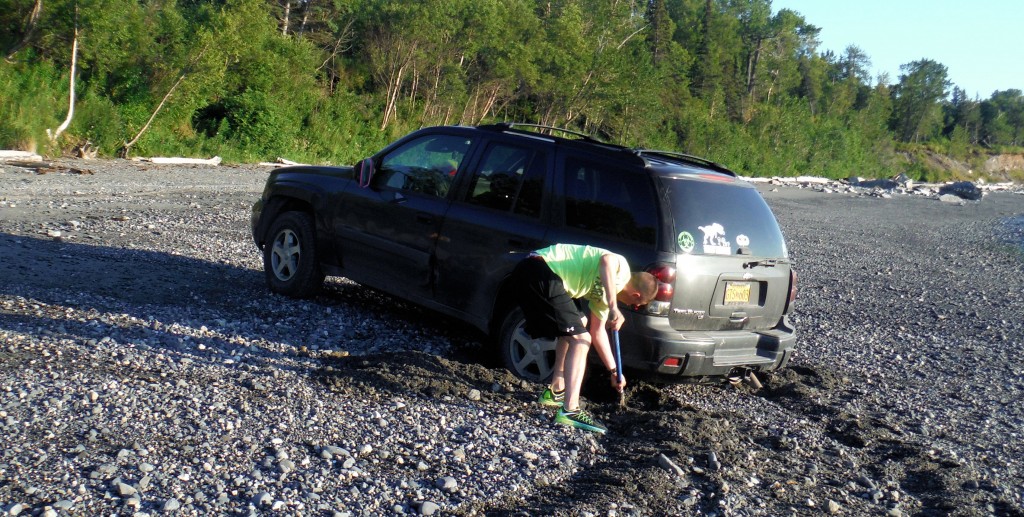
He had gone venturing out without 4WD working, and the soft wet sand was just too much for only 2WD. We tried with a shovel, and we got him loose, but he couldn’t get back up to the road. Needless to say, Ranger Ralph and industrious Opa came to the rescue. Not very difficult, and we had them out in about 20 minutes. Everybody was pretty happy.
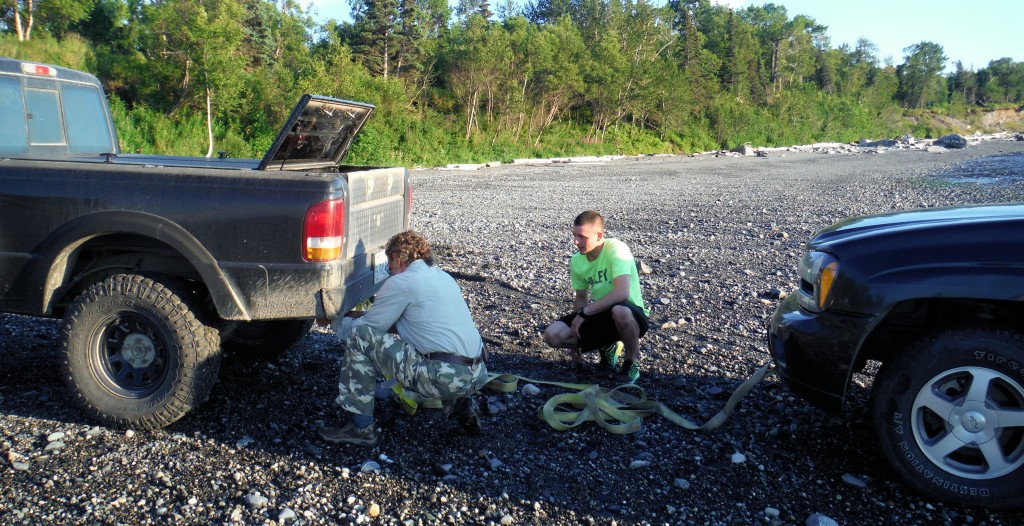
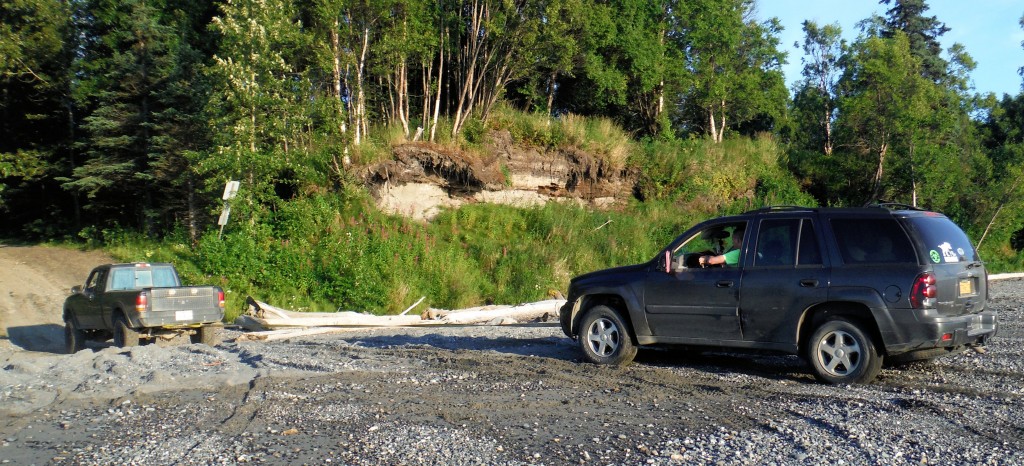
Huge, lonely beach; trusty four-wheel-drive; gorgeous, loveable companion. How does life get any better than this?
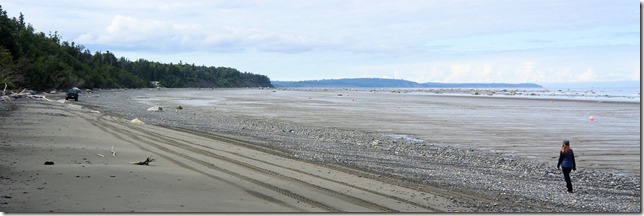
Tomorrow, we are treating ourselves to a fine experience: we are going to fly across the Inlet to Wolverine Creek, and spend some time watching the bears go fishing. And who knows, maybe catch one or two of those pink-meat fishes for ourselves.
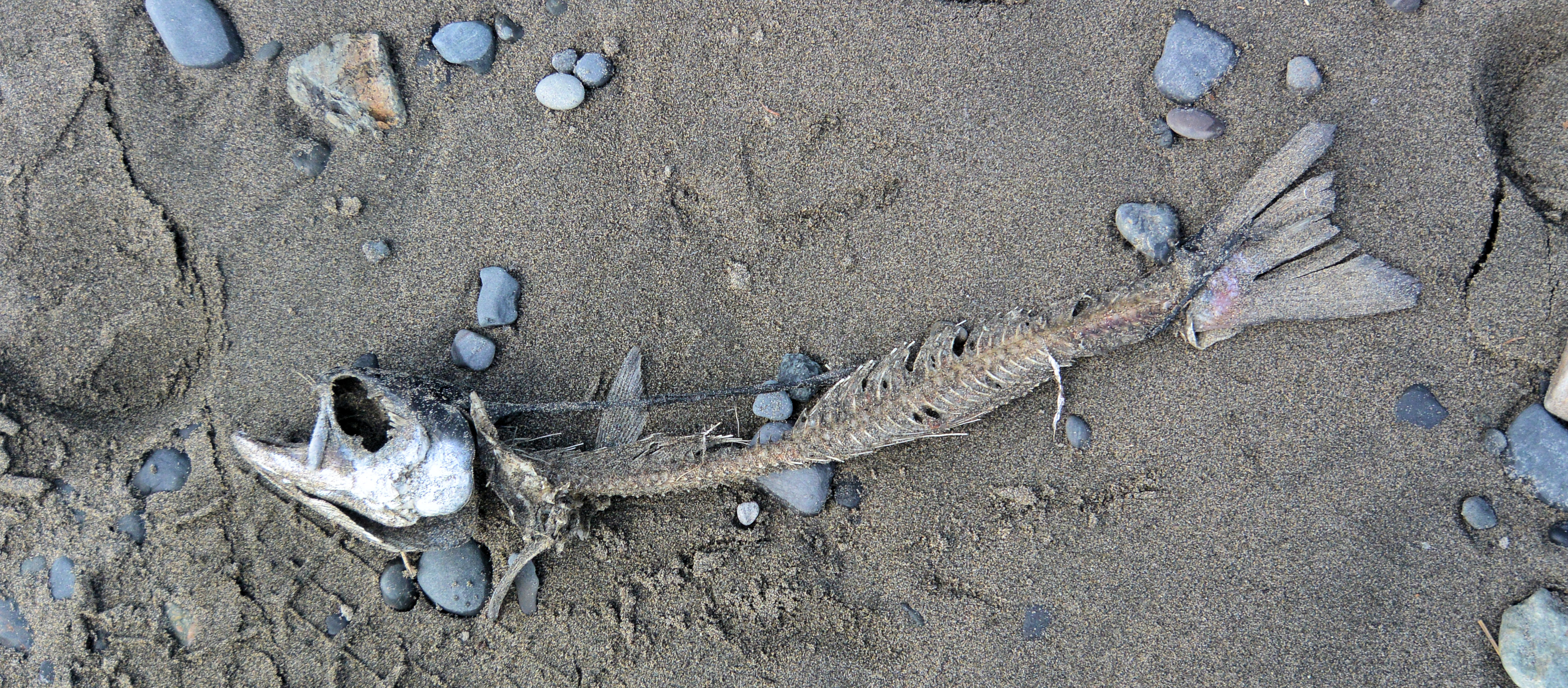
Excellent coverage of my most frequent rec areas!! Can’t wait to hear about your adventures at Wolverine Creek…
waiting for your Wolferine Creek experience.
thanks again for a great story and pictures..tony L.